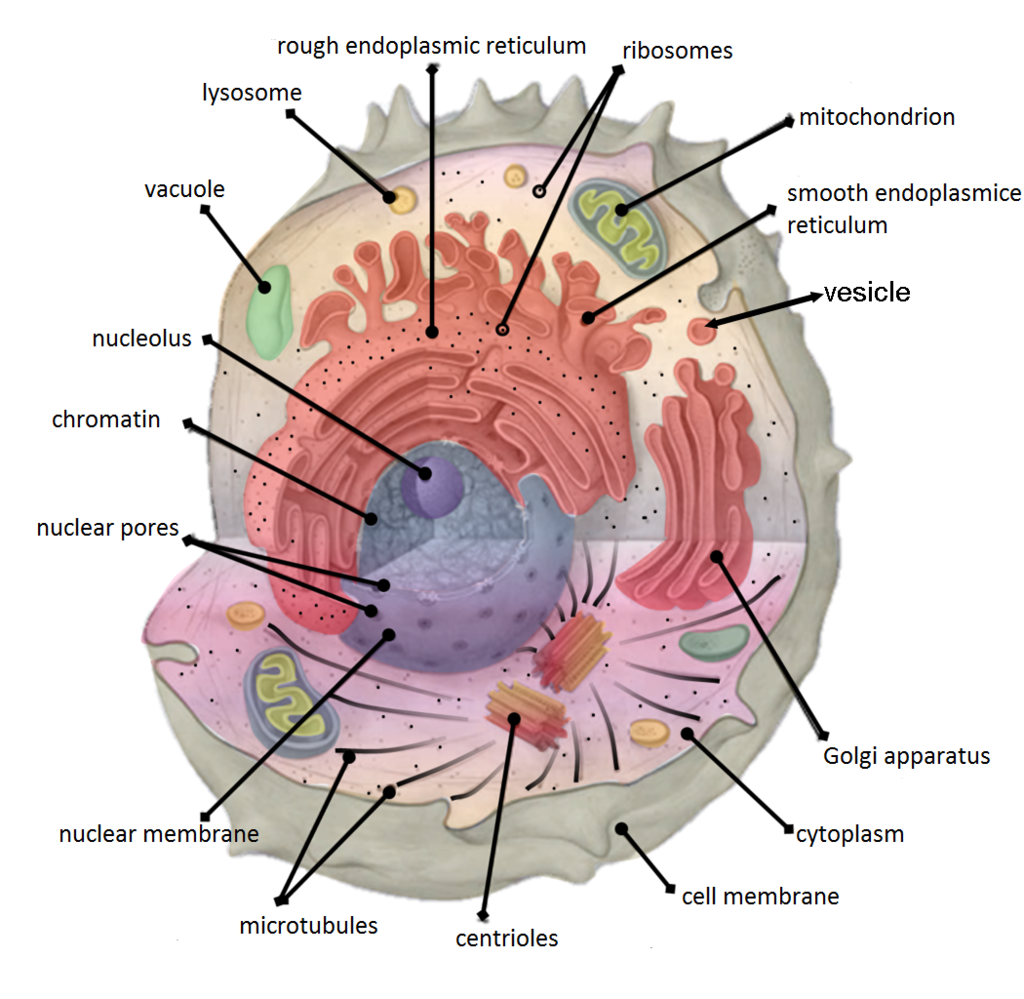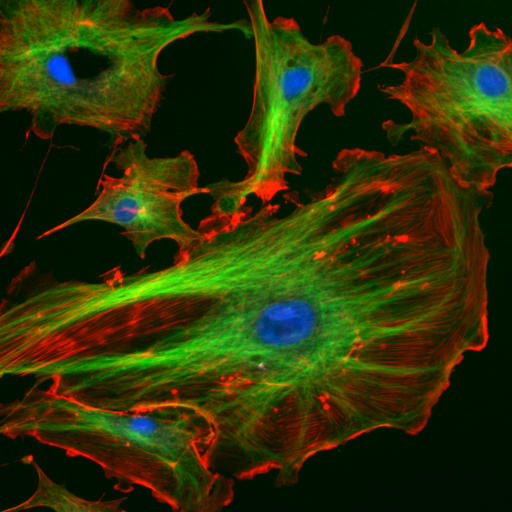31 4.5 Cytoplasm and Cytoskeleton
Created by: CK-12/Adapted by Christine Miller

A Peek Inside the Cell
Figure 4.5.1 is an artist’s representation of what you might see if you could take a peek inside one of these basic building blocks of living things. A cell’s interior is obviously a crowded and busy space. It contains cytoplasm, dissolved substances, and many structures. It’s a hive of countless biochemical activities all going on at once.
Cytoplasm
Cytoplasm is a thick, usually colourless solution that fills each cell and is enclosed by the cell membrane. Cytoplasm presses against the cell membrane, filling out the cell and giving it its shape. Sometimes, cytoplasm acts like a watery solution, and sometimes, it takes on a more gel-like consistency. In eukaryotic cells, the cytoplasm includes all of the material inside the cell but outside of the nucleus, which contains its own watery substance called the nucleoplasm. All of the organelles in eukaryotic cells (such as the endoplasmic reticulum and mitochondria) are located in the cytoplasm. The cytoplasm helps to keep them in place. It is also the site of most metabolic activities in the cell, and it allows materials to pass easily throughout the cell.
The portion of the cytoplasm surrounding organelles is called cytosol. Cytosol is the liquid part of cytoplasm. It is composed of about 80 per cent water, and it contains dissolved salts, fatty acids, sugars, amino acids, and proteins (such as enzymes). These dissolved substances are needed to keep the cell alive and carry out metabolic processes. Enzymes dissolved in cytosol, for example, break down larger molecules into smaller products that can then be used by organelles of the cell. Waste products are also dissolved in the cytosol before they are taken in by vacuoles or expelled from the cell.

Cytoskeleton
Although cytoplasm may appear to have no form or structure, it is actually highly organized. A framework of protein scaffolds called the cytoskeleton provides the cytoplasm and the cell with structure. The cytoskeleton consists of thread-like microfilaments, intermediate filaments, and microtubules that criss-cross the cytoplasm. You can see these filaments and tubules in the cells in Figure 4.5.2. As its name suggests, the cytoskeleton is like a cellular “skeleton.” It helps the cell maintain its shape and also helps to hold cell structures (like organelles) in place within the cytoplasm.
Feature: Human Biology in the News
News about an important study of the cytoplasm of eukaryotic cells came out in early 2016. Researchers in Dresden, Germany discovered that when cells are deprived of adequate nutrients, they may essentially shut down and become dormant. Specifically, when cells do not get enough nutrients, they shut down their metabolism, their energy level drops, and the pH of their cytoplasm decreases. Their normally liquid cytoplasm also assumes a solid state. The cells appear dead, as though a kind of rigor mortis has set in. The researchers think that these changes protect the sensitive structures inside the cells and allow the cells to survive difficult conditions. If nutrients are returned to the cells, they can emerge from their dormant state unharmed. They will continue to grow and multiply when conditions improve.
This important basic science research was executed on a nonhuman organism: one-celled fungi called yeasts. Nonetheless, it may have important implications for humans, because yeasts have eukaryotic cells with many of the same structures as human cells. Yeast cells appear to be able to “trick” death by shutting down all life processes in a controlled way. Through continued study, researchers hope to learn whether human cells can be taught this “trick” as well.
4.5 Summary
- Cytoplasm is a thick solution that fills a cell and is enclosed by the cell membrane. It has many functions. It helps give the cell shape, holds organelles, and provides a site for many of the biochemical reactions inside the cell.
- The liquid part of the cytoplasm is called cytosol. It is mainly water, and it contains many dissolved substances. The cytoplasm of a eukaryotic cell also contains a membrane-enclosed nucleus and other organelles.
- The cytoskeleton is a highly organized framework of protein filaments and tubules that criss-cross the cytoplasm of a cell. It gives the cell structure and helps hold cell structures (such as organelles) in place within the cytoplasm.
4.5 Review Questions
- Describe the composition of cytoplasm. Draw a picture of a cell, including the basic components required to be considered a cell, and the organelles you have learned about in this section.
- What are some of the functions of cytoplasm?
- Outline the structure and functions of the cytoskeleton.
- Is the cytoplasm made of cells? Why or why not?
- Name two types of cytoskeletal structures.
- In the picture of the different cytoskeletal structures above (Figure 4.5.2), what do you notice about these different structures?
- Describe one example of a metabolic process that happens in the cytosol.
- In eukaryotic cells, all of the material inside of the cell, but outside of the nucleus is called the ___________ .
- What is the liquid part of cytoplasm called?
- What chemical substance composes most of the cytosol?
- When yeast cells deprived of nutrients go dormant, their cytoplasm assumes a solid state. What effect do you think a solid cytoplasm would have on normal cellular processes? Explain your answer.
4.5 Explore More
Cytoskeleton Structure and Function, National Center for Case Study
Teaching in Science, 2015.
Attributions
Figure 4.5.1
Cell-organelles-labeled by Koswac on Wikimedia Commons is used under a CC BY-SA 4.0 (https://creativecommons.org/licenses/by-sa/4.0) license.
Figure 4.5.2
Cytoskeleton/ Fluorescent Cells by National Institute of Health (NIH) on Wikimedia Commons is released into the public domain (https://en.wikipedia.org/wiki/Public_domain).
National Center for Case Study Teaching in Science. (2015, August 3). Cytoskeleton structure and function. YouTube. https://www.youtube.com/watch?v=YTv9ItGd050&feature=youtu.be
The smallest unit of life, consisting of at least a membrane, cytoplasm, and genetic material.
The jellylike material that makes up much of a cell inside the cell membrane, and, in eukaryotic cells, surrounds the nucleus. The organelles of eukaryotic cells, such as mitochondria, the endoplasmic reticulum, and (in green plants) chloroplasts, are contained in the cytoplasm.
The semipermeable membrane surrounding the cytoplasm of a cell.
Cells which have a nucleus enclosed within membranes, unlike prokaryotes, which have no membrane-bound organelles.
A central organelle containing hereditary material.
A solution, similar to the cytoplasm of a cell, enveloped by the nuclear envelope and surrounding the chromosomes and nucleolus.
A tiny cellular structure that performs specific functions within a cell.
The aqueous component of the cytoplasm of a cell, within which various organelles and particles are suspended.
Long chains of hydrocarbons with a carboxyl group and a methyl group at opposite ends. Can be either saturated, containing mostly single bonds between adjacent carbons, or unsaturated, containing many double bonds between adjacent carbons.
The generic name for sweet-tasting, soluble carbohydrates, many of which are used in food. The various types of sugar are derived from different sources. Simple sugars are called monosaccharides and include glucose, fructose, and galactose.
Amino acids are organic compounds that combine to form proteins.
A class of biological molecule consisting of linked monomers of amino acids and which are the most versatile macromolecules in living systems and serve crucial functions in essentially all biological processes.
Biological molecules that lower amount the energy required for a reaction to occur.
A complex network of interlinking protein filaments that extends from the cell nucleus to the cell membrane, gives the cell its shape and help organize the cell's parts.

